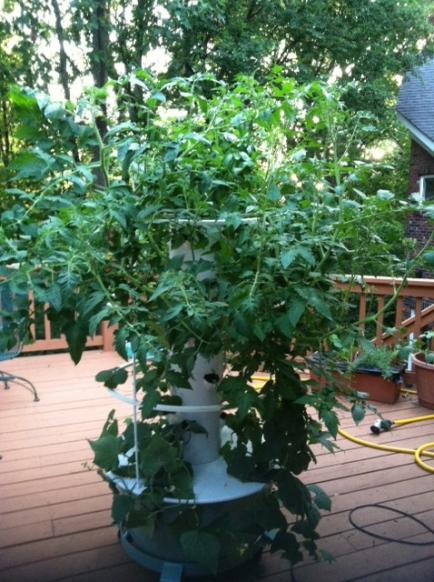The importance of planning crop placement is one thing that many growers overlook whether their garden is indoors, outside, growing in soil, or soillessly. Hindsight is 20-20; a situation that even the experienced gardener finds themselves faced with from time to time. Whether the light source is the sun or grow lights, you still have to consider shade versus light – even in vertical gardens.
 Shade is a bigger issue in the indoor garden than outside, but with a garden planted in a tower the realization that plant placement that isn’t well thought through when growing with this setup outdoors is a surprise that won’t do your harvest any favors. One would expect the sun to hit the full length of the tower evenly – but it won’t. Not if you have larger plants above shorter or smaller ones, and of course, by the time this discovery is made the season will be quite advanced. Indoors such an error in garden planning can be corrected with vertically installed grow lights around the walls of the grow space. This is probably not an increased cost that the average new grower will be expecting, but it will ensure you have food to eat from your efforts even though you made a colossal planting error.
Shade is a bigger issue in the indoor garden than outside, but with a garden planted in a tower the realization that plant placement that isn’t well thought through when growing with this setup outdoors is a surprise that won’t do your harvest any favors. One would expect the sun to hit the full length of the tower evenly – but it won’t. Not if you have larger plants above shorter or smaller ones, and of course, by the time this discovery is made the season will be quite advanced. Indoors such an error in garden planning can be corrected with vertically installed grow lights around the walls of the grow space. This is probably not an increased cost that the average new grower will be expecting, but it will ensure you have food to eat from your efforts even though you made a colossal planting error.
In the image above the gardener actually planted strawberries, lettuce, and basil in the middle of the tower. Look how much sun those plants are enjoying just 2 months after the tower was planted. Of course, it is pretty hard to envision what will happen from start to harvest when your planting looks like this image at the left in the beginning. This is where mature plant size research and planning placement before germination is very helpful.
 While this particular newcomer to hydroponic gardening is delighted at his small harvests from 2.5 square-feet of deck space, he could have had a far better lettuce and basil harvest if he’d put them above the tomatoes as not much abundance can possibly be going on below them 2 months after planting his tower. It also looks like his vertical garden isn’t getting a lot of sun early or late in the day between the obstruction of the house and thick trees surrounding it, which will make the situation on the tower amplified. While many lettuces will quickly go to seed when temperatures soar in summer, there are bolt-resistant varieties that you can harvest from 8-10 weeks after planting in the outdoor garden. Indoor garden growing of the same lettuce varieties will also extend your harvest length – but not when you plant like this without side lighting.
While this particular newcomer to hydroponic gardening is delighted at his small harvests from 2.5 square-feet of deck space, he could have had a far better lettuce and basil harvest if he’d put them above the tomatoes as not much abundance can possibly be going on below them 2 months after planting his tower. It also looks like his vertical garden isn’t getting a lot of sun early or late in the day between the obstruction of the house and thick trees surrounding it, which will make the situation on the tower amplified. While many lettuces will quickly go to seed when temperatures soar in summer, there are bolt-resistant varieties that you can harvest from 8-10 weeks after planting in the outdoor garden. Indoor garden growing of the same lettuce varieties will also extend your harvest length – but not when you plant like this without side lighting.
Another reason that planning your plant placement on a vertical garden is important is plant support. Tomatoes, cucumbers, and all other vine-type or sprawling plants need trellising – or some form of behavioral assistance. It is often seen in photos of different vertical garden designs that the grower has the tomatoes on top of the tower. Unless you’ve found a midget tomato variety some engineering is going to be necessary as your plant(s) grow, because even the determinate habit forms do not grow totally upright. The weight of the fruit always causes flopping stems. How will you keep tomatoes in a reasonable arrangement to allow working around the tower sides, or keeping your fruit off the ground or floor? If you try top-placed tomatoes in the indoor vertical garden be prepared to rig up support that is anchored to the ceiling.
Here’s a prime example of what happens when you plant a vertical garden using inspiration, and not planned planting.